These sweet and crunchy anise biscotti will transport you to Italy in just one bite! I love that you can make these cookies in advance to enjoy anytime, anywhere (they freeze beautifully).
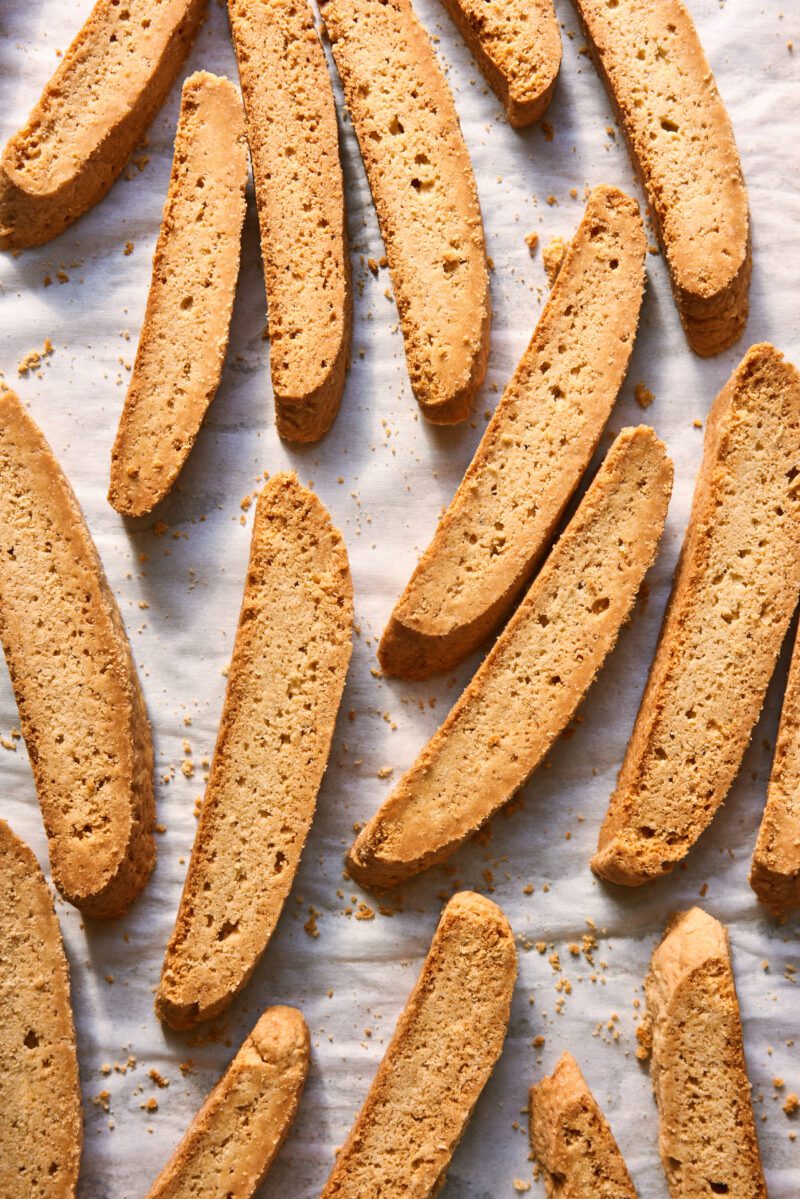
When you think of biscotti, the crunchy, twice-baked Italian cookies destined for dunking, what flavor comes to mind first? Vanilla biscotti? Almond? Chocolate?
If anise biscotti are not on your radar yet, welcome to the most delicious “Italian-bakery” taste worthy of any espresso or dessert wine. These cookies are warm and welcoming with subtle hints of buttery, anise flavor (not strong like Sambuca). Just the aroma itself will make you happy.
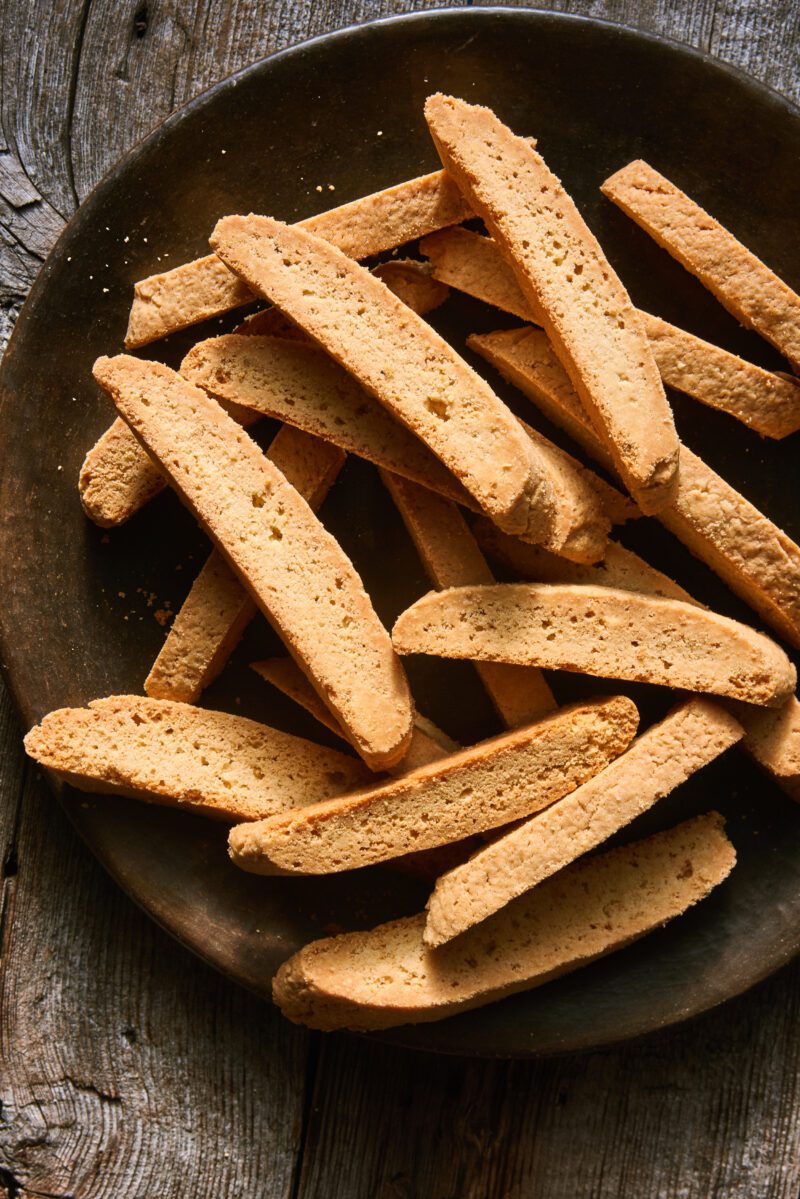
The Star Ingredient.
Anise extract is a popular flavoring used in Italian cakes, cookies and pastries. It’s made from steeping star anise (you know it, it looks like a cute little wooden star) in alcohol to extract the natural flavor.
The aroma is reminiscent of fennel or licorice, which most people assume is too strong. However, when used in small amounts, especially when combined with butter, the flavor is not overpowering at all. It’s enhancing. Anytime I make anise biscotti, I get rave reviews and unexpected smiles all around. This is my go-to recipe.
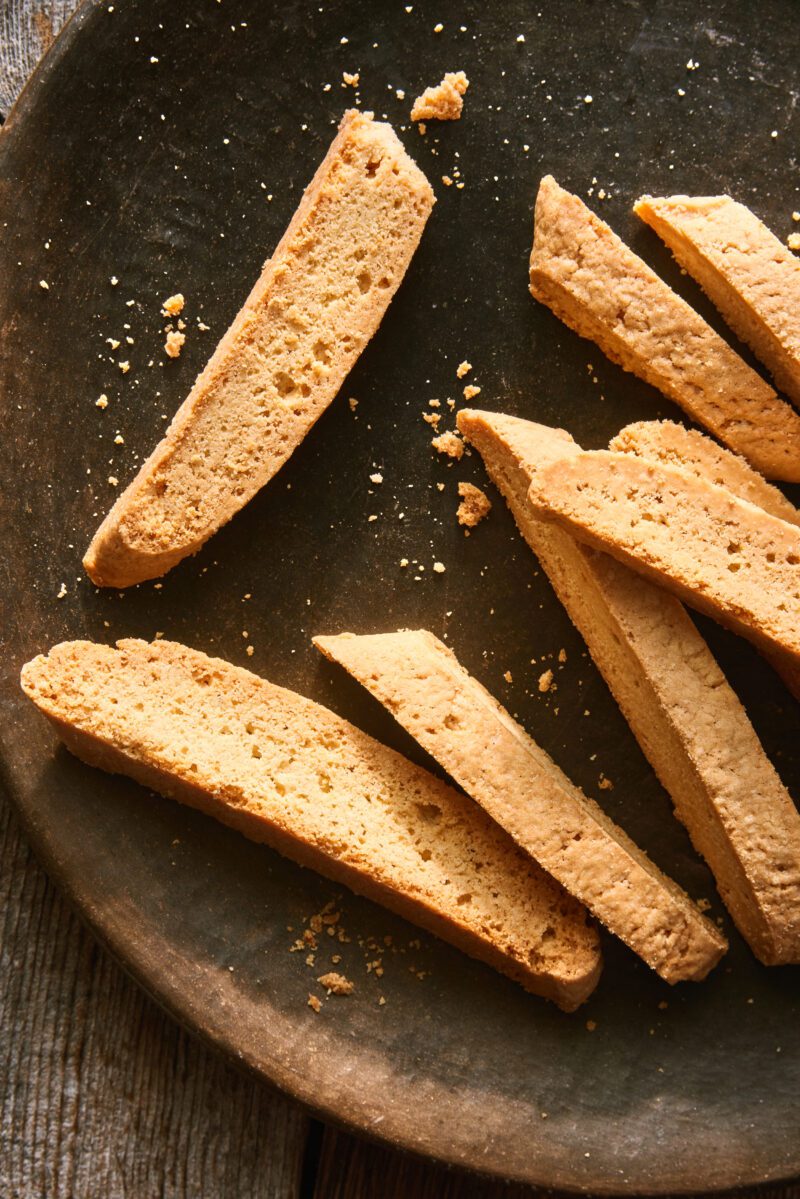
Italian Anise Biscotti Ingredients: You Will Need
- Butter
- Granulated sugar
- Anise extract
- Vanilla extract
- Eggs
- All purpose flour
- Baking powder
- Fine sea salt
How To Make Biscotti (At A Glance)
Biscotti are twice-baked cookies. First, you’ll make the biscotti dough which looks more like cookie batter than actual dough. It’s a bit sticky. Then, you’ll form the dough into logs, and bake side-by-side on a baking sheet until cooked through. That’s the “first bake.” To finish, you’ll cut the logs into diagonal slices (use a large serrated knife) and bake again until golden brown, crisp and delicious.
Biscotti Tips:
- Use a stand mixer: Biscotti dough is slightly sticky. Using an electric stand mixer or hand-held mixer will make your life easier when creaming the butter and sugar together. But of course, you can mix by hand too!
- Flour everything. When shaping the biscotti, make sure to lightly flour your work surface and hands to prevent sticking. The dough will be easier to handle and roll around.
- Make it ahead. Biscotti keep for several weeks at room temperature or frozen in an airtight container.
- No Anise extract? No problem. Use a tiny drop of anise oil instead. The flavor is stronger but it will get the job done.
How to Freeze Biscotti
Just like my Italian sesame cookies, you can freeze anise biscotti with excellent results. Place baked and cooled biscotti into an airtight container separated by sheets of parchment paper. Store in the freezer for up to 1 month. Defrost on the kitchen counter at room temperature.
More Italian Dessert Recipes to Try!
- Classic Italian Sesame Cookies (Reginelle Cookies)
- Italian Pignoli Cookies
- One-Bowl Italian Almond Ricotta Cake
- Rich & Fudgy Torta Caprese
*Photo credit & styling: Melina Hammer.
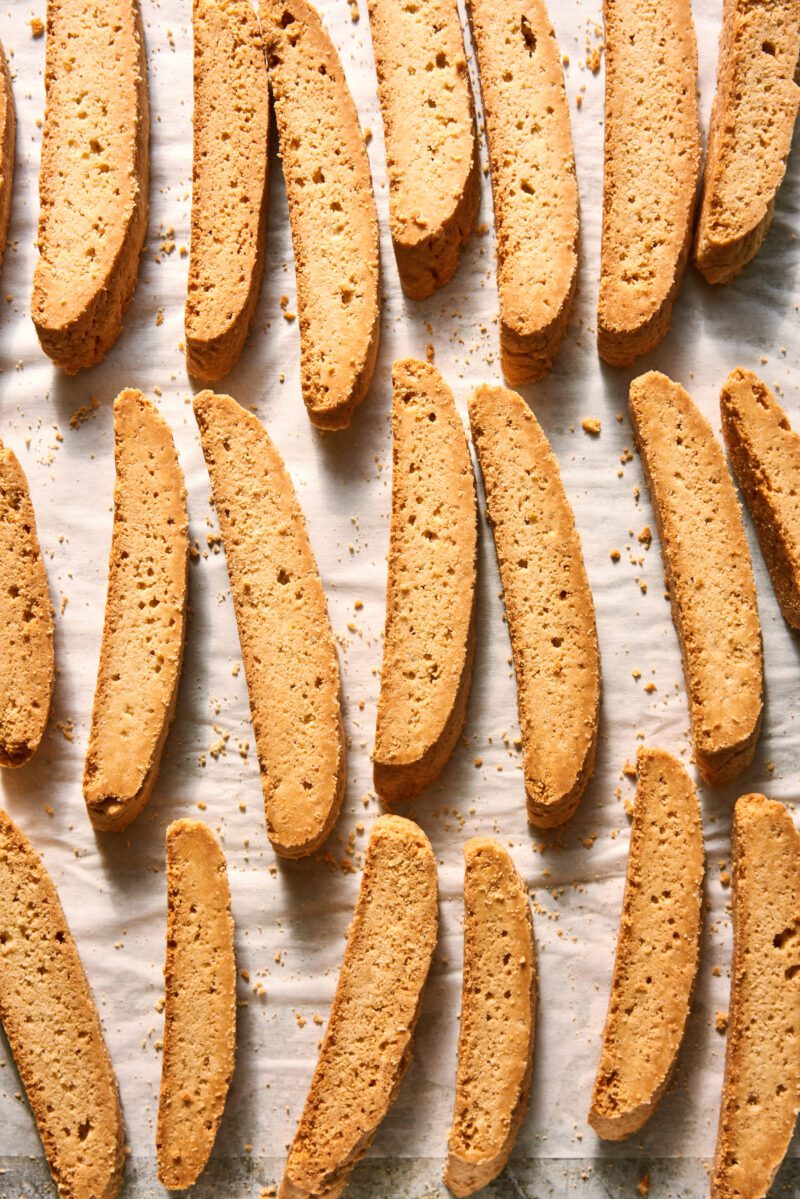

Italian Anise Biscotti
- Prep Time: 30
- Cook Time: 50
- Total Time: 1 hour 20 minutes
- Yield: 28-32 biscotti
- Category: Cookies
- Method: Oven-Baked
- Cuisine: Italian
- Diet: Vegetarian
Description
This anise biscotti recipe will transport you to Italy in just one bite! So buttery, crisp and delicious! They will keep at room temperature in an air-tight container for 1 month (if you don’t eat them all first!) or in the freezer for up to 3 months.
Ingredients
- 120 g (8 tbsp) unsalted butter, softened
- 150 g (3/4 cup) granulated sugar
- 2 tsp anise extract (use up to 1 tbsp. for more flavor)
- 1 tsp vanilla extract
- 2 large eggs (about 107 g cracked weight)
- 265 g (2 cups) King Arthur all purpose flour
- 1 1/2 tsp. baking powder
- 1/2 tsp. fine sea salt
Instructions
- Preheat your oven to 325 F.
- Coat a sheet pan with butter (or spray oil). Line with parchment paper to stick.
- In an electric stand mixer fitted with the paddle attachment: cream the butter and sugar until light and fluffy, about 2 minutes. Add the eggs, one at a time, beating well after each addition. Add the anise and vanilla extracts. Scrape down the sides of the bowl with a rubber spatula. It will smell delicious!
- In a separate bowl, sift together the flour baking powder and salt.
- With the mixer running, gradually add the flour mixture to the butter mixture. Mix until just combined. Note: if the dough is too sticky, add more flour, 1 tbsp at a time. The texture should be soft and malleable, but not overly wet and sticky. You will be hand-rolling the dough in the next step.
- Scoop the dough onto a lightly floured surface (I use a fine mesh strainer to evenly dust my work surface to prevent sticking). With floured hands, gently form the dough into a ball. Divide the ball in half. Roll each half into a thick log, about 8 inches long by 2 inches wide. To do so: lift the dough up and roll the logs vertically in between your palms, gently stretching them to size. Alternatively, roll the logs on your work surface.
- Set the logs onto your baking sheet spaced 5 inches apart. Brush off any residual flour on the surface. Gently flatten the logs to 2 1/2- 2 3/4-inches wide.
- Bake on the center rack for 25-30 minutes. This is your first bake. When ready, the logs will be light in color and just starting to turn golden around the edges. There will be cracks on the surface- all normal.
- Remove the baking sheet from the oven. Transfer the logs a wire rack to cool, about 20-30 minutes.
- With a large serrated knife, cut the logs (on a diagonal) into 1/2-inch slices. The slices will still be slightly warm at this point. You should end up with 28-32 biscotti, depending on how you cut them.
- Arrange the biscotti, cut side down, onto your baking sheet. Bake for 20 minutes, flipping them over at the halfway mark. Keep an eye on them as they bake. You’re looking for a slightly darkened exterior with a lighter, “almond color” interior. Adjust bake time as needed.
- Remove from the oven. Transfer to a wire rack to cool.
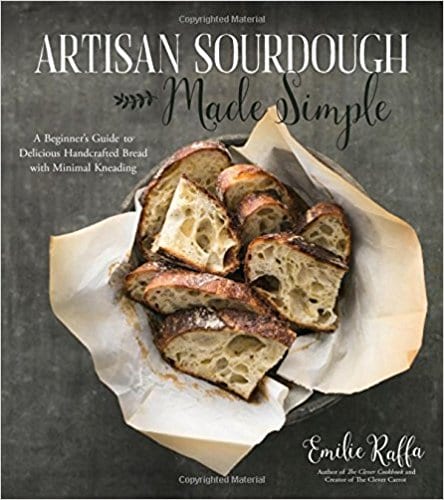

Comments
Vicky says
Hi,
I used this recipe to make biscotti for the first time. The recipe
is easy to follow and they came out GREAT. Just what I
was looking for!
Do you have any recommendations on how to adjust the recipe if
I want to use less sugar and/or add sliced almonds?
Thanks so much!
Angie F. says
Hi! I would love to use some sourdough starter in this recipe. How would I modify to do that? Thank you!
Leslye says
Why do you butter the baking sheet if you also cover it with parchment? Isn’t the parchment enough? In the past I’ve made biscotti using a silpat (no parchment, no buttering). Very easy clean up.
Emilie Raffa says
Hi Leslye! I do this to prevent the dough from “pulling up” the parchment if it’s sticky in some spots. For example, after shaping the dough into logs and placing them onto the parchment paper, if you need to move or reposition them for whatever reason, the dough might stick and shift the positioning of the paper. Does that make sense? Coating the pan in butter or spray oil first anchors the parchment paper to the pan. As you’ve mentioned, a silicone mat is a good alternative and is actually more practical; it’s heavier than parchment paper so no need to coat the pan! Hope this helps :)
Varun says
Looks so scrumptious! Can I make this gluten free? Thanks
Emilie Raffa says
I haven’t tried it. But it should work well with an all-purpose 1:1 GF flour. I recommend King Arther GF Measure for Measure flour- it’s excellent!
CB says
This is a great recipe for biscotti, Emilie, and you broadcast it just in time for the Christmas Holidays, too!! Thank you! I always found the “twice-baked” (hence Bis Cotti) to be somewhat off-putting & laborious, but your recipe simplifies the process so nicely. I am gathering ingredients and will bake a few batches this rainy weekend in the Seattle area.
If you would like to venture into new flavor territory, then instead of using Anise, I would suggest trying “Fiori di Sicilia”. This is the quintessential flavor essence that is used in Italy for traditional panettone. My Nonna made panettone flavored biscotti at Christmas and they were the bomb! They hold up to dunking in a latte or cappuccino and bring that wonderful panettone flavor. The authentic Fiori di Sicilia flavoring can be purchased at King Arthur Flour online.
Emilie Raffa says
Oh yes. I know Fiori di Sicilia very well! I use it in my ricotta cookies. My mom adds just a drop to her cranberry sauce at Thanksgiving. And if I ever venture into homemade sfogliatelle, I might add some to the filling to replace the orange peel. What a heavenly extract! I like the idea of adding it to biscotti as well… I can smell the aroma as I type this!
CB says
Homemade sfogliatelle? Wow! I’ll be on the lookout for that recipe and technique, for sure. They are one of our favorites, but a daunting task to prepare and construct. I’m certain that you could break the process down to something that’s do-able. I have made the so called “lazy sfogliatelle” (Google for techniques) using store bought puff pastry sheets and homemade filling, but they fall short of the real deal.
Annier says
Is it possible to use anise seed instead of the anise extract? If so how much would be the proper substitution?
Emilie Raffa says
This is a great question. Star anise and anise seed have similar flavor profiles, but are two different things. Star anise (used as extract in this recipe) has a distinct aromatic “licorice” flavor. Anise seed has a stronger “fennel” flavor (think: Italian sausage). Some recipes use them interchangeably. However, I think they taste very different. If this doesn’t bother you, go ahead and use anise seed. 1-2 teaspoons should be sufficient depending on your preference. You can leave the seeds whole or grind them up in a spice grinder for a finer texture.
CMR says
I was really excited to learn that we can freeze the biscotti treats! Had no idea! This will make a great addition to our Christmas desserts and snacks! Also thanks again for the clear recipe ( and photos)! I will be back with another review after our first batch!
Emilie Raffa says
Yes! Freezing biscotti is the best. And so convenient. Just defrost at room temperature while you make your coffee ;) Enjoy xo